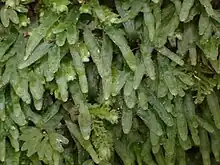| Pallaviciniaceae | |
|---|---|
 | |
| Prionothallus xiphoides | |
| Scientific classification | |
| Kingdom: | Plantae |
| Division: | Marchantiophyta |
| Class: | Jungermanniopsida |
| Order: | Pallaviciniales |
| Suborder: | Pallaviciniineae |
| Family: | Pallaviciniaceae Migula, 1904 |
| Genera | |
|
See text | |
| Synonyms | |
|
List
| |
Pallaviciniaceae is a widely distributed family of liverworts in the order Pallaviciniales. All species are thallose, typically organized as a thick central costa (midvein), each side with a broad wing of tissue one cell in thickness. All species are dioicous. The greatest diversity is in Australasia, with some species endemic to that region, though species belonging to the family may be found on every continent except Antarctica.[1]
Species
- Greeneothallus Hässel
- Jensenia Lindb.
- Pallavicinia Gray
- Pallavicinius
- Podomitrium Mitt.
- Prionothallus Mamontov, Vilnet & Schäf.-Verw.
- Seppeltia Grolle
- Symphyogyna Nees & Mont.
- Symphyogynopsis Grolle
- Xenothallus R.M.Schust.
Evolutionary history
One of the oldest known bryophytes is Pallaviciniites of the Devonian, discovered in New York. It bears strong similarities to extant thallus liverwort genus Pallavicinia, hence the name.[3]
References
- ↑ Schuster, Rudolf M. (1992). The Hepaticae and Anthocerotae of North America (volume V ed.). Chicago: Field Museum of Natural History. ISBN 0-914868-20-9.
- ↑ "Pallaviciniaceae". www.gbif.org. Retrieved 15 December 2023.
- ↑ Michael, Dunn. "Pallavicinites devonicus (Huber) Schuster". Ohio University. Retrieved June 14, 2019.
This article is issued from Wikipedia. The text is licensed under Creative Commons - Attribution - Sharealike. Additional terms may apply for the media files.